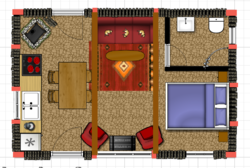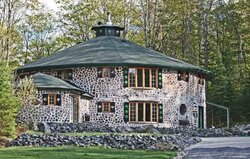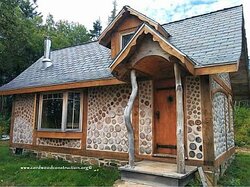Hello!
I'm new to the forum, and so glad I found y'all!
I'm building a 400-square-foot cordwood cabin and need to pick out a wood stove. In case you've never heard of cordwood construction, it's where you build a frame, such as timber frame, then infill with short log ends held together with mortar. The finished walls look a bit like stacked firewood. Wall thickness can vary from 8 inches to 26 inches thick. My walls will be 12 inches (the mortar part), with 14 inch log ends for infill.
The cabin will have a shed-style roof that is 14 feet at the front (high) end and 8 feet high at the back (low) end. It will also have six windows and front and back doors, the glass kind.
Okay, my first question is: I'm leaning toward the Englander 13-NC model for my cabin. Would that be a mistake, given how small my cabin is? I have no problem keeping a window or door cracked to keep it from getting too toasty.
My second question is: It will be going in a corner, between an electric range and the back wall of the cabin. It will be positioned at an angle in the corner. The distance from the electric range to that back wall will be 40 inches. Do you think that would work with the clearances for the 13-NC? I would be fine with putting up wall protection all around the wood stove.
Third and final question: Any other suggestions for other wood stoves I might investigate? I'd like to be able to use at least 16" logs and I prefer steel over cast iron and American-made over non-American-made. Or Canadian!
Here's my floor plan to give you a visual.
Thanking you all in advance!
—CabinCrazy

I'm new to the forum, and so glad I found y'all!
I'm building a 400-square-foot cordwood cabin and need to pick out a wood stove. In case you've never heard of cordwood construction, it's where you build a frame, such as timber frame, then infill with short log ends held together with mortar. The finished walls look a bit like stacked firewood. Wall thickness can vary from 8 inches to 26 inches thick. My walls will be 12 inches (the mortar part), with 14 inch log ends for infill.
The cabin will have a shed-style roof that is 14 feet at the front (high) end and 8 feet high at the back (low) end. It will also have six windows and front and back doors, the glass kind.
Okay, my first question is: I'm leaning toward the Englander 13-NC model for my cabin. Would that be a mistake, given how small my cabin is? I have no problem keeping a window or door cracked to keep it from getting too toasty.
My second question is: It will be going in a corner, between an electric range and the back wall of the cabin. It will be positioned at an angle in the corner. The distance from the electric range to that back wall will be 40 inches. Do you think that would work with the clearances for the 13-NC? I would be fine with putting up wall protection all around the wood stove.
Third and final question: Any other suggestions for other wood stoves I might investigate? I'd like to be able to use at least 16" logs and I prefer steel over cast iron and American-made over non-American-made. Or Canadian!
Here's my floor plan to give you a visual.
Thanking you all in advance!
—CabinCrazy

Last edited by a moderator:



